|
|
Created/dedicated as per personal communication with Melissa Humphreys, August 12, 2011
Updated as per James P. Tuttle's The Hawk Moths of North America, August 13, 2011
Updated as per BAMONA, August 13, 2011
Updated as per personal communication with Timmee Robertson, August 13, 2014
|
Sphingidae Larval Checklist
San Joaquin County, California
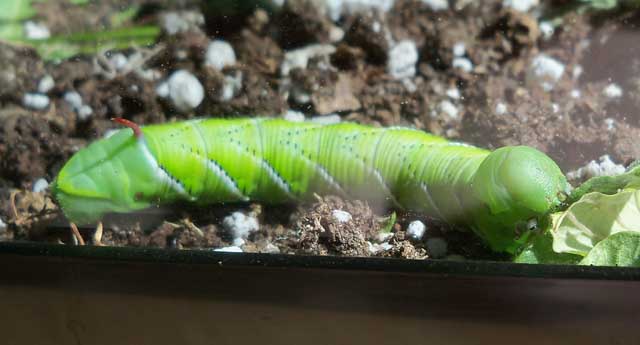
Manduca sexta fifth instar, San Joaquin County, California,
feeding on potato foliage, August 12, 2011, courtesy of Melissa Humphreys.
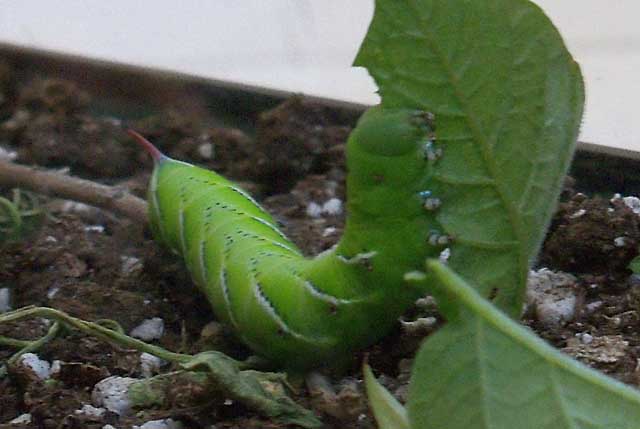
Manduca sexta fifth instar, San Joaquin County, California,
feeding on potato foliage, August 12, 2011, courtesy of Melissa Humphreys.
For care of "found larvae/caterpillars" visit Manduca sexta larva, central Texas,
August 21, 2008, Trina Woodall.
This page is dedicated to Melissa Humphreys, San Joaquin County, California. Melissa Humphreys provides the images of Manduca sexta (larva)
and Eumorpha achemon (adult moth) on top and bottom of this page, respectively.
Melissa writes, August 12, 2011, "I live in the Central Valley in California (San Joaquin County). I found a tomato hornworm in my garden eating the grape leaves so
I brought it inside and took care of it so the birds wouldn't get it. It is now a moth.
When I look up pictures for the tomato hornworm moth it looks completely different, and pictures of the pandorus worm looks completely different from the
caterpillar I had. I'm a little confused.
"Also, is it common for these little guys to be picky eaters? I found a second worm in my garden after the first had already entered pupa stage.
The first liked grape leaves but the second won't eat anything but potato leaves. It's really picky."
I reply, "Hi Melissa,
"The caterpillar eating the grape leaves was not a tomato hornworm. They do not eat grape leaves. It was most likely a caterpillar of Eumorpha achemon.
I suspect the moth is also an Eumorpha achemon. The Pandorus Sphinx does not fly in California.
"If you or one of your friends has a camera and can take some pictures and send them to me as jpg attachments, I can make better determinations.
"Different Sphingidae species do eat different foodplants, but often a single species will eat more than one foodplant.
"I have just received your pictures. The moth is Eumorpha achemon. It came from the "fat caterpillar" without a horn that was eating grape foliage.
The caterpillar with the red horn (bottom of page) is Manduca sexta."
Thirty-two Sphingidae species are listed on the BAMONA website for California. Not all of the species are reported by BAMONA for San Joaquin.
(Four species: Manduca sexta, Pachysphinx occidentalis, Hemaris thetis, Arctonotus lucidus are listed by BAMONA for San Joaquin County)
A green BAMONA indicates the moth is reported on the BAMONA website and/or in Moths of Western
North America, #2. Distribution of Sphingidae of Western North America, revised, an excellent little booklet available through Paul Opler.
Please help me develop this list with improved, documented accuracy by sending sightings (species, date, location), preferably with an
image, via email to Bill Oehlke.
Please also forward sightings to BAMONA, an excellent online resource.
Many thanks also to Timmee Robertson who sends the following images.

Eumorpha achemon fifth instar, on grape,
Stockton, San Joaquin County, California,
August 12, 2014, courtesy of Timmee Robertson.

Manduca sexta fifth instar, on tomato,
French Camp, San Joaquin County, California,
August 10, 2014, courtesy of Timmee Robertson.
Visit San Joaquin County Sphingidae Adult Sphinx Moths; Hawkmoths.
Visit California Catocala: Underwing Moths.
If you are travelling, you can find active Sphingidae checklists for all countries in North, Central, and South America and the Caribbbean via the links at
North, Central, South American Sphingidae checklists
Sphinginae subfamily
Sphingini tribe:

|
Manduca quinquemaculatus
WO,
the Five-spotted Hawkmoth
The caterpillars are called Tomato Hornworms and each has a black horn at the end of the abdomen.
Larvae feed on potato, tobacco, tomato, and other plants in the
nightshade family (Solanaceae). There is also a very beautiful brown form. See bottom of page.
|
 |
Manduca sexta
BAMONA/MH, the Carolina Sphinx
Tobacco Hornworms, equipped with a red-tipped horn at the end of the
abdomen, are true gluttons and feed on tobacco and tomato, and
occasionally potato and pepper crops and other plants in the
nightshade family (Solanaceae).
|
Manduca sexta larva on potatoe, August 12, 2011, Melissa Humphreys
 |
Sphinx chersis
WO, the Great Ash Sphinx.
The larvae are pale bluish green. The head has a pair of yellow
lateral bands meeting at the apex.
Larval hosts are ash, lilac, privet, cherry, and quaking aspen.
|
 |
Larvae hide in the day and feed primarily on cherry, plum, and apple
at night. Larvae have been found on Amelanchier nantuckensis
in Massachusetts and have been reared to pupation in Michigan on
Prunus serotina. Note purple oblique lines.
|
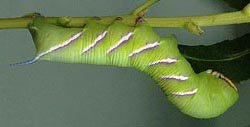 |
Sphinx perelegans
WO, the Elegant Sphinx;
A unique feature of this larva is a shield on the first thoracic
segment, which is of the same colour as the body and which forms a
tight-fitting hood over the vertex of the head. This hides a pair of
glossy black spots on top of the head, which are revealed if the
animal is disturbed.
|
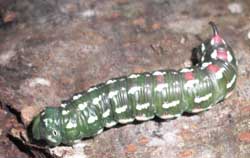 |
Larvae feed on California juniper (Juniperus californica) and Rocky Mountain juniper (J. osteosperma).
|
Smerinthini Tribe:
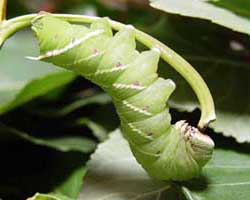 |
Larvae feed on cottonwood and poplar (Populus) and willow
(Salix).
Larvae are very chunky with little to distinguish them
from Pachysphinx modesta.
|
 |
Smerinthus cerisyi
WO,
Cerisy's Sphinx;
Cerisyi larvae greatly resemble modesta larvae, both being pale
green, with granular skin, pale lateral diagonal lines, faint red
spiracular circles, and very pale longitudinal lines running from the
head to a more pronounced anal diagonal line.
Larvae have green heads bounded dorsally with a pale yellow
inverted "V".
|
Macroglossinae subfamily
Dilophonotini Tribe:
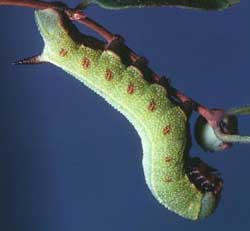 |
Larval host plants include Snowberry (Symphoricarpos),
honeysuckle (Lonicera), Coralberry, viburnums, high bush cranberry and hawthorn (Crataegus).
Horn is black with a slightly lighter base. This western species was formerly classified as
H. diffinis or H. senta. Those species west of the Continental Divide are now classified as
H. thetis.
|
Philampelini Tribe:
 |
Eumorpha achemon
MH,
the Achemon Sphinx:
Larvae feed upon Grape (Vitis), Virginia Creeper
(Parthenocissus quinquefolia) and other vines and ivies
(Ampelopsis).
Larvae occur in both a light (green) form and a darker (tan/brown)
form. Note six "segmented" oblique lines, as well as absence of anal horn in final instar.
|
Eumorpha achemon adult moth, August 12, 2011, from found larva, Melissa Humphreys
Macroglossini Tribe:
 |
Hyles lineata
WO, the White-lined Sphinx
Larvae are highly varied and feed on a great diversity of plants
including willow weed (Epilobium), four o'clock (Mirabilis),
apple (Malus), evening primrose (Oenothera), elm
(Ulmus), grape (Vitis), tomato (Lycopersicon),
purslane (Portulaca), and Fuschia.
All larvae seem, however, to have the red/black swellings split by
dorso-lateral lines. |
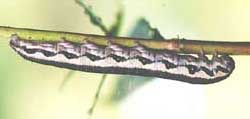 |
Larvae feed on elegant fairyfan (Clarkia unguiculata) in the evening primrose family (Onagraceae). |
|
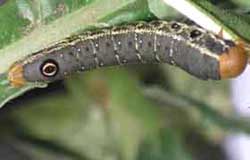 |
Proserpinus lucidus
BAMONA, Pacific Green
Sphinx Moth or Bear Sphinx. Larvae feed on evening primrose
(Oenothera dentata var. campestris) and clarkias. David Wikle
fed them on both Mexican evening primrose, Oenothera berlandieri
and evening primrose, Oenothera biennis. (formerly classified as Arctonotus lucidus) |
|
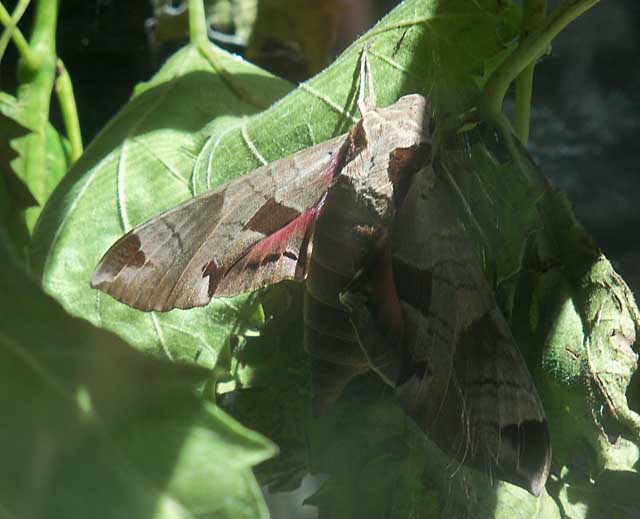
Eumorpha achemon, San Joaquin County, California,
August 12, 2011, from found larva, courtesy of Melissa Humphreys.
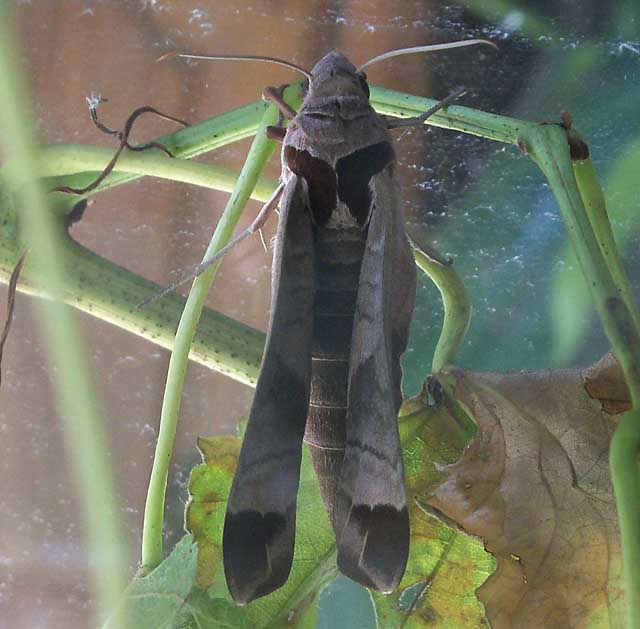
Eumorpha achemon inflating, San Joaquin County, California,
August 12, 2011, from found larva, courtesy of Melissa Humphreys.
When the moths first emerge from their pupae, their wings are short, stubby and quite soft. The moth needs to climb and hang to that it can pump fluid into its
wing veins so the wings can properly inflate and then stiffen for flight. Melissa Humphreys has sent an image (above) with the wings almost completely inflated.
The wings probably would have been only 1/4 to 1/3 as long when the moth first broke forth from its pupa.
Enjoy some of nature's wonderments, giant silk moth cocoons.
These cocoons are for sale winter and fall. Beautiful Saturniidae moths will emerge the following spring and summer.
Read Actias luna rearing article. Additional online help available.
Use your browser "Back" button to return to the previous page.
This page is brought to you by Bill Oehlke and the
WLSS. Pages are on space rented from Bizland. If you would like to become a "Patron of the Sphingidae Site", contact Bill.
Please send sightings/images to Bill. I will do my best to respond to requests for identification help.
 | 
Show appreciation for this site by clicking on flashing butterfly to the left.
The link will take you to a page with links to many insect sites. |




















